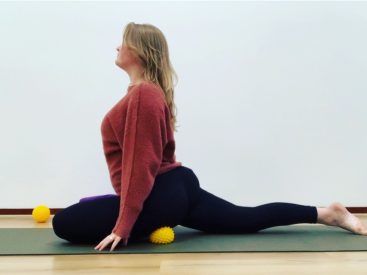In our fast-paced, high-stress modern lives, finding moments of deep relaxation and restoration has become crucial. This is where restorative yoga comes in. Unlike other more dynamic types of yoga, restorative yoga offers a gentle and soothing practice that promotes relaxation, healing, and inner balance. In this blog, we will explore the essence of restorative yoga, its benefits, and how it can nourish your body and mind.
What is Restorative Yoga?
Restorative yoga is a practice that focuses on slowing down and creating a calming space for deep relaxation. It involves holding simple postures for extended periods. Typically, 5–20 minutes, using props such as blankets, bolsters, and blocks to support and embellish the pose. The intention is to create an environment that enables the body to release tension. Soothe the nervous system, and achieve a profound sense of relaxation.
Benefits of Restorative Yoga
Stress Reduction
One of the most recognized benefits of restorative yoga is its ability to activate the parasympathetic nervous system. Which is responsible for the body’s relaxation response. This promotes a decrease in heart rate, lowers blood pressure, and reduces stress hormone levels. So the body can move into a state of deep relaxation.
Physical Healing
By allowing the body to fully rest and rejuvenate, this slow yoga form supports the healing process. It helps in reducing muscle tension, easing chronic pain, and increasing the body’s overall flexibility and joint mobility.
Mental and Emotional Well-being
Encourages mindfulness and introspection, creating a space for self-reflection and emotional healing. The focus on deep breathing and relaxation activates the relaxation response, leading to improved mental clarity, decreased anxiety, and a sense of inner peace.
Better Sleep Quality
Regular practice has shown to have a positive impact on sleep quality. By reducing stress and promoting relaxation, it can help calm the mind, release physical tension, and prepare the body for a restful night’s sleep.
Improved Body Awareness
Restorative yoga draws attention to body sensations and cues, facilitating a deeper connection between the mind and body. This heightened awareness can translate into better posture, enhanced body alignment, and improved overall body awareness both on and off the mat.
The difference between Restorative Yoga and Yin Yoga
Restorative yoga and Yin yoga are both gentle and slow-paced practices that promote relaxation and mindfulness. However, there are a few key differences between the two:
Intention
Restorative yoga primarily focuses on relaxation and restoration, aiming to calm the nervous system and provide deep physical and mental rejuvenation. The use of props and longer holds in restorative yoga helps release tension and support the body in achieving a state of deep relaxation.
Yin yoga, on the other hand, involves holding passive poses for an extended period (typically 3-5 minutes or more) to target the deeper connective tissues of the body, such as ligaments, tendons, and fascia. The intention of Yin yoga is to increase flexibility, improve energy flow, and stimulate deep tissue release, with a particular focus on the hips, pelvis, and spine.
Posture Variations
In restorative yoga, props like bolsters, blankets, and blocks are extensively used to provide support and enhance comfort in each pose. This allows the body to fully relax, ensuring that there is no strain or effort required.
Contrastingly, in Yin yoga, while the use of props is not as prominent, practitioners still use some props, such as blocks or bolsters, to find a comfortable edge in the pose. The main purpose is to find a moderate level of sensation or stretch, without pushing into discomfort or pain.
Duration and Intensity
Restorative yoga poses are typically held for longer periods—ranging from 5 to 20 minutes—allowing the body to completely surrender and relax. The overall intensity is very low, with the focus being on deep relaxation and restoration.
Yin yoga poses are also held for extended periods, but not to the same degree as in restorative yoga. The duration of holds can vary, and the level of intensity can be more moderate. Yin yoga encourages practitioners to find an appropriate edge, where they experience a gentle, sustained stretch without strain.
In conclusion, both yoga forms offer unique benefits for relaxation and stress reduction. Restorative yoga emphasizes deep relaxation and rejuvenation, utilizing props for complete support, while Yin yoga focuses on gentle stretches and deep tissue release through longer holds. Exploring both practices can provide a well-rounded experience and ultimately help you find the one that best suits your needs and preferences.
Conclusion
In a world that seems to constantly demand our attention, restorative yoga offers a much-needed reprieve. By devoting time to this gentle practice, we can unwind, replenish, and reconnect with ourselves on a deeper level. Whether you are seeking stress relief, physical healing, or simply a moment of peace, this yoga form can provide the nurturing space you need to nurture your body and mind along your journey to wellness.




